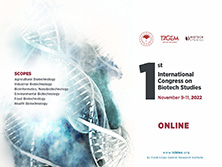MORPHOLOGIC, PHENOLOGIC AND AGRONOMIC CHARACTERISTICS OF SOME COMMON VETCH GENOTYPES UNDER UNIRRIGATED CONDOTIONS
2 Atatürk Üniversitesi, Ziraat Fakültesi, Tarla Bitkileri Bölümü, Erzurum - In this study, 12 common vetch genotypes which had been obtained from various sources were used. Experiment was carried out under dry land conditions in Pasinler (Erzurum) for two years (1992-93). The results obtained in the trial are as follows;
1. Seedling number per m2 ranged from 69.2-112.8, with the local populations having the highest seedling.
2. The period of sowing to 50% flowering ranged between 65.3-92.8 days. The earlist flowering genotypes is Horasan, but the latest is Prussia.
3. Plant height varied from 40.2 to 52.3 cm.
4. The highest green herbage yield (1023.0 kg/da) vas produced by Ürem-79 and the lowest was from by Prussia (907.3 kg/da). The hay yield ranged from 220.4 to 255.9 kg/da, with Ürem-79 and Kars having the lowest.
5. Crude protein content varied from 17.39 to 19.53%. The highest crude protein yield was produced by Ürem-79 (50.2 kg/da), and the lowest by Pasinler local population (40.2 kg/da).
6. The number of pods Per plant varied from 5.5 to 10.2 and the number of seeds per pod between 2.2 and 4.5. 1000 seed weight varied 58.3 and 73.9 g. Accession no 20-1 had the highest while 17-1 had the lowest seed weight.
7. Cv. Prussia could not complete its maturation at harvest, seed yield was excluded from statistical analysis. Seed yield ranged from 80.9 to 104.8 kg/da, whereas straw yield (left over after threshing) ranged from 161 2 to 211.3 kg/da.
8. A positive and significant correlation was observed between hay yield and plant height, green herbage and crude protein yield and pod Per plant; seed yield and seedling number, pods Per plant and seeds Per pod. Correlations between seed yield and the period of sowing to 50% flowering and 1000 seed weight was significant and negative.
















